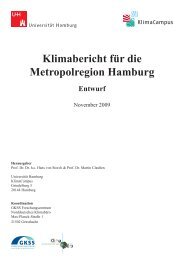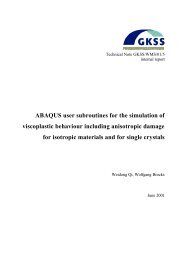Dynamics and Vulnerability of Delta Systems - loicz
Dynamics and Vulnerability of Delta Systems - loicz
Dynamics and Vulnerability of Delta Systems - loicz
Create successful ePaper yourself
Turn your PDF publications into a flip-book with our unique Google optimized e-Paper software.
A 70% decrease in the Danube’s sediment discharge following construction <strong>of</strong> Iron Gate dams in the<br />
1970s <strong>and</strong> 1980s, coupled with eustatic sea level rise <strong>and</strong> engineering projects that redistribute<br />
sediments, is affecting the delta especially at its coastal fringe. Rates <strong>of</strong> vertical change in the nearshore<br />
zone radically changed from natural accumulation at active river mouths to a dominantly<br />
erosional pattern along most <strong>of</strong> the coast. Intensive canalization in the latter half <strong>of</strong> 20 th Century lead<br />
to dramatically increased sediment deposition on the delta plain <strong>and</strong> within lakes that compensates<br />
decreasing sediment discharge linked to damming. However, shoaling <strong>and</strong> increased turbidity in<br />
lakes could have a negative impact in the long run, even if the high connectivity between the lakes<br />
provided by canalization may be currently favorable for the aquatic ecosystem (Coops et al. 2008).<br />
Planned new development related to shipping <strong>and</strong> tourism is one <strong>of</strong> the key threats for the delta. A<br />
much contested deep-water shipping canal along the Chilia arm <strong>of</strong> the Danube to the Bastroe mouth<br />
in the Black Sea was planned <strong>and</strong> partially executed by the Ukraine, despite concerns regarding its<br />
potential for ecosystem damage <strong>and</strong> pollution (Schiermeier 2004, Wong et al. 2007). Access by boat<br />
only, which traditionally provided a certain degree <strong>of</strong> inaccessibility <strong>and</strong> helped preserve the delta, is<br />
currently threatened by construction <strong>of</strong> access roads <strong>and</strong> an increase in tourism-related boating <strong>and</strong><br />
residences in the Romanian part <strong>of</strong> the delta. While pollution in the delta decreased considerably<br />
after the collapse <strong>of</strong> Communist economies, the Danube River collects waters from 19 European<br />
countries <strong>and</strong> continues to be the largest polluter <strong>of</strong> the Black Sea basin (Kideys 2002).<br />
Fig. CS5: A synthetic look at large-scale human intervention in the Danube delta (Giosan et al., unpublished<br />
data). Canals dug within the delta are shown for two different phases <strong>of</strong> canalization. The course for the planned<br />
Chilia-Bastroe Canal is shown. Principal areas reclaimed for agriculture at the end <strong>of</strong> 20 th Century are indicated<br />
by a red mask. On the coastal fringe <strong>of</strong> the delta the shoreline retreated for most <strong>of</strong> the region relative to the<br />
1856 coast (in black), except for the active Chilia lobe. Based on analysis <strong>of</strong> historic surveys, rates <strong>of</strong> vertical<br />
change in the nearshore zone radically changed from a natural pattern <strong>of</strong> accumulation at active river mouths<br />
<strong>and</strong> erosion in between (from 1856 to 1898 as shown in the figure) to a dominantly erosional pattern at present<br />
(not shown). Note the wave-influence indicative <strong>of</strong> erosional regime suggested by the straightening <strong>of</strong> the Chilia<br />
coast (A) <strong>and</strong> development <strong>of</strong> barrier isl<strong>and</strong>s <strong>and</strong> spits in areas A, B, <strong>and</strong> C.<br />
25





